
@ShahidNShah


Microtia is a congenital condition in which the outer ear is underdeveloped or absent. This condition affects both appearance and hearing, as the ear canal and middle ear structures may also be affected. Scientists have chipped away at the mystery of this condition for years, and a significant chunk of the puzzle has finally fallen into place—genes are to blame. Once the diagnosis is confirmed, the right treatment falls into place. It’s all about mapping the journey.
What causes microtia? The answer lies in our genes, and groundbreaking research has brought us closer to understanding this complex condition. But that’s not all – digital health innovations are revolutionizing how we support individuals with microtia.
Microtia can appear in two ways: as an isolated condition or part of a syndrome, which may include other abnormalities like cleft palate or craniofacial deformities. Mastering this distinction makes all the difference in providing top-notch care.
Several genes have been closely linked to microtia:
The genetic mutations in microtia can vary, and they impact the condition in different ways:
As genetic research sheds new light on microtia, the potential for digital health tools to transform diagnosis, treatment, and care becomes increasingly evident.
Today’s genetic testing allows for early identification of microtia-related mutations, enabling more precise care. With a detailed understanding of their child’s genetic blueprint, parents can respond to their child’s distinct needs, crafting a customized approach that drives real progress and tangible results.
For those needing reconstructive surgery, 3D printing has revolutionized prosthetic creation. What if prosthetic ears could be made to fit seamlessly, offering unparalleled comfort, natural looks, and improved functionality? This tech makes that vision a reality. Think of 3D models as a surgeon’s GPS – they help chart the safest, most effective route to the desired outcome, reducing unnecessary risk and uncertainty along the way.
Telemedicine has made it easier for patients with microtia to receive care, no matter where they live. Specialists are just a video call away, providing patients with direct access to expert opinions and ongoing support – no lengthy travel is required.
In addition to advances in prosthetics and telemedicine, modern surgical techniques have evolved to offer more personalized solutions for patients with microtia. With 3D imaging and modeling, doctors are now able to map out customized treatment plans that cater specifically to each patient’s individual anatomy. This precision enables surgeons to deliver natural-looking restorations that skillfully recreate the subtleties of human form, helping patients look and feel whole again.
Clinics such as Tahiri Plastic Surgery offer comprehensive surgical options for those seeking specialized care. These include techniques that focus on both aesthetics and function, helping patients achieve the best possible results. This approach underscores the importance of combining technological innovations with expert care to improve both hearing and appearance in individuals affected by microtia.
Catching microtia early is vital for kids who face a double whammy: self-consciousness about their appearance and struggles with hearing. At birth, a microtia diagnosis initiates a healthcare response that intertwines genetic insight, audiological evaluations, and—if needed—surgical reconstruction options to provide comprehensive support. When different specialists collaborate, the sum of their expertise amounts to truly holistic care for each patient. A medical dream team comes together to offer top-notch care. These specialized pros—pediatricians, audiologists, geneticists, and plastic surgeons—pool their expertise to create personalized treatment plans that make a real difference.
When it comes to microtia, supporting a child’s overall well-being means not only correcting physical anomalies but also addressing the psychological and social challenges that come with them. For kids with noticeable ear differences, everyday social interactions can be a major struggle, and self-doubt can creep in. A team approach to counseling, where the child and their family receive support together, can help families navigate rocky times and emerge stronger on the other side.
With the rapid progress of genetic testing, doctors can now pinpoint connections between certain syndromes, significantly refining their approach to care. Genetic insights give clinicians sharp foresight into potential health concerns, clearing the way for individualized care plans that tackle more than just symptoms. When we prioritize comprehensive care from the get-go, we see people bounce back stronger, with better-coping skills and more enduring relationships.
What happens when genetic investigation meets digital health innovation? Breakthroughs in microtia understanding and treatment – and they’re happening now. At the heart of it all is genetic testing, the gateway to personalized care. Integrating game-changers like 3D printing and telemedicine allows us to craft care plans that speak directly to individual needs.
Microtia no longer has to mean limitation. Thanks to innovative tools, individuals can look forward to a life where better health and new possibilities converge.

Fiber laser technology has revolutionized numerous industries with its precision and efficiency, and medical manufacturing is no exception. This advanced technology plays a pivotal role in the …
Posted Sep 19, 2024 Biomedical Technology Fundamental Technologies Medical Devices
Connecting innovation decision makers to authoritative information, institutions, people and insights.
Medigy accurately delivers healthcare and technology information, news and insight from around the world.
Medigy surfaces the world's best crowdsourced health tech offerings with social interactions and peer reviews.
© 2025 Netspective Foundation, Inc. All Rights Reserved.
Built on Apr 17, 2025 at 6:07am